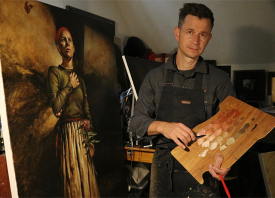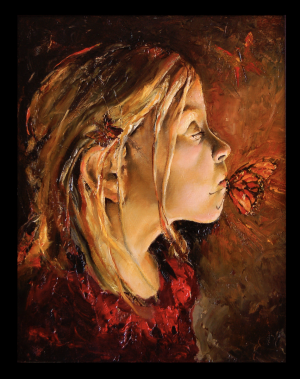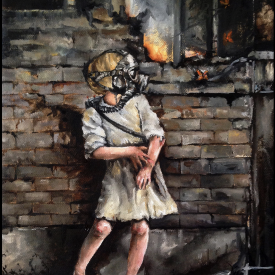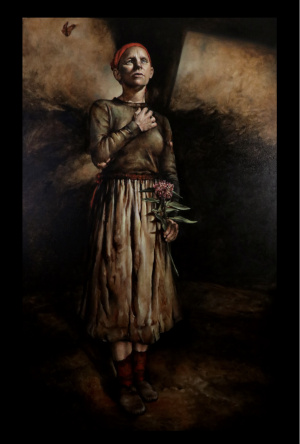Caniglia brings light and darkness to explore the human condition

By Cindy Murphy McMahon
Jeremy Caniglia cannot be easily described. First off, you would begin with “widely acclaimed artist.” Then it gets more nuanced: illustrator, art historian, curator, teacher, lecturer, human rights activist and environmental advocate.
Caniglia, MSEDU’16, inhabits many worlds at once. The Creighton University graduate and Creighton Prep High School teacher describes his artwork as “light in the midst of darkness using timeless motifs.”

Huh, you might ask?
The statement becomes clearer by viewing some of Caniglia’s paintings and illustrations. The images sometimes reveal the darkest parts of human nature and are at once haunting, otherworldly, and even grotesque. Some convey utter despair, while others strikingly illuminate hope and beauty. All make exquisite use of light, reminiscent of Old World Masters – the most recognized European artists from about 1300 to 1800.
His themes are life, love, death and rebirth. Caniglia expresses those themes through depictions of screams, moans, skulls, terror, starvation, war, corpses. But also joy, peace, children, cherubs and butterflies.
In other words, the complexity of the human condition, with all its delight and suffering.
As an illustrator and film concept artist with a global following, Caniglia’s work has been featured in more than 100 novels, and numerous magazines, movies, albums and comic books. The list of well-known authors who have commissioned his illustrations is a

veritable Who’s Who of horror and fantasy, including Stephen King, Ray Bradbury, Max Brooks, Peter Straub, William Peter Blatty, and Michael Moorcock.
Yet, he’s not really a huge fan of horror.
“So many people believe I watch horror films and the like,” Caniglia laughs. “In reality, the books that I illustrated for that industry were based on how scared I was after reading each book.”
There’s definitely more, so much more, to Caniglia than those commercial successes.
He has shown his work professionally for more than 25 years in galleries and museums around the world, and his paintings explore climate change, wars, revolution, poverty and endangered species. He has been particularly influenced by DaVinci (1452–1519) and Caravaggio (1571-1610).
He hopes he has helped viewers of his art “in some small way to make sense of the horror they see on the news and in their day-to-day lives.”
He also describes himself as “anti-establishment,” saying, “I began using my artwork in the late ‘80s and early ‘90s to confront issues of universal concern. My deep commitment to human rights, social justice and biodiversity has never swayed.”

He is particularly grateful for the Jesuits, “who fight for social justice on so many levels.
“I was so thankful for Pope Francis' encyclical Laudato Si' on the care of our planet and common home. It is such an important letter that is both a warning to wake up and address climate change and what is happening in our own backyards.”
Caniglia’s article in the latest issue of Fine Art Connoisseur discusses the techniques Caravaggio used when he painted David and Goliath. In fact, Caniglia created an exact replica that took him two years and will be on display in Denver next February, in a show he is curating titled “A Matter of Light and Death.”
He also has been working on a commissioned painting of Santa Lucia (Saint Lucy) for Carlentini, Sicily. “It is such an honor to have my beloved saint placed in the Mother Church in Sicily,” he says of his family’s Sicilian roots.
Caniglia, who lives in Omaha, holds a BFA from Iowa State University and an MFA from the Maryland Institute College of Art. In 2017, he had a once-in-a-lifetime chance to study in Norway under the tutelage of Odd Nerdrum. The renowned figurative painter chooses only three students at a time from around the world to study with him.

Caniglia considers Nerdrum, who is often compared to Rembrandt, the greatest figure painter of our time.
“I learned a lifetime about Old Master techniques that are all but lost in today’s world,” he enthusiastically recalls. “Nerdrum is so well versed in the ancients and loves to talk about philosophy from the Greeks, the Renaissance and into the Baroque. He has an entire library with ancient maps and books. We would have world discussions nightly.”
But wait, don’t forget. Jeremy Caniglia is also a teacher.
He first began teaching in 2005 in a community art program, and he enjoyed it so much that he enthusiastically agreed to be an adjunct art instructor at Creighton.
“I loved teaching drawing and advanced painting techniques, as well as drawing the figure and teaching students about medical illustration,” Caniglia says, “which was something I had learned in Baltimore with Johns Hopkins as a grad student at the Maryland Institute of Art.”
In 2012 an opportunity arose with his alma mater, Creighton Prep (Omaha’s Jesuit high school). He suggested to administrators a new curriculum that featured book illustration, medical illustration and advanced painting with Old Master techniques, as well as advanced figure drawing.
The school hired him to bring his skill set so that students could compete for top scholarships. Shortly thereafter, he returned to Creighton as a student himself, enhancing his teaching skills with a master’s degree in education, which he completed in 2016.
The accomplished artist who had experienced world-class success in so many ways had found a whole new calling.
“I found that I truly love teaching and it was a vocation for me, a calling from my heart. I wanted to inspire the next generation of artists.”
Why teach high school and not college?

“College is wonderful but watching high school students rise to the occasion is amazing.
I have students who by their junior year can paint as advanced as most college juniors or seniors,” he says.
His professional hero Nerdrum wholeheartedly endorses artists being teachers.
“He believes every painter should also teach because it makes them understand their craft so much better and fine-tunes them. It also makes you dig deeper and understand the purpose behind our own work and subject matter.”
Caniglia sees this play out in his own life today, at 53. After finishing a day in the high school classroom, he drives some 20 blocks to his home in midtown Omaha.
Then, he is “so energized from the creative level that my classrooms produce, that when I get home, I paint into the evenings. And in the summer months, I paint entire new exhibitions. It really keeps you focused on what you and your work are about.”
He says he applies what he learned from Nerdrum not only to his art but also his teaching. “I now have worldly conversations with my students. We talk about social justice messages that they may use in their subject matter and paintings.”
It’s obvious that his pride in his students is equal to, if not greater than, pride in his own work.
He eagerly mentions his Creighton Prep Chapel program, which has resulted in more than 20 “Old Master highly detailed paintings of the saints and more,” all done by students.
“People ask if the paintings are bought, or if I painted them, and I say no, this is what our youth are capable of when they are given a chance to shine.”